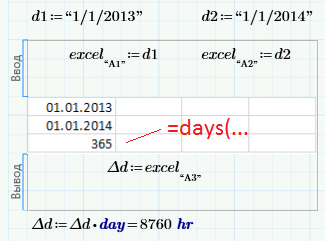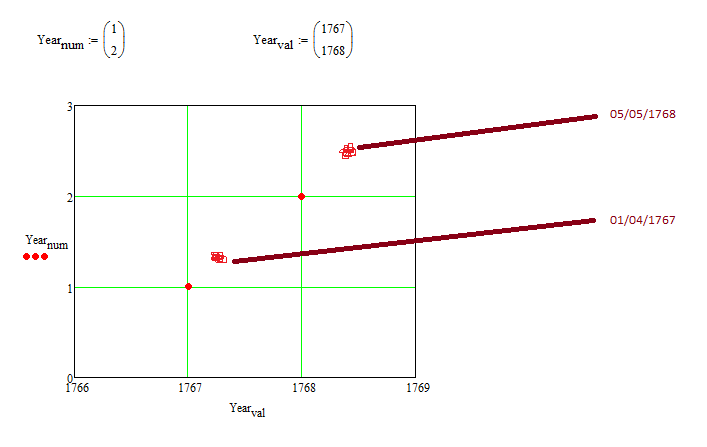Community Tip - Your Friends List is a way to easily have access to the community members that you interact with the most! X
- Subscribe to RSS Feed
- Mark Topic as New
- Mark Topic as Read
- Float this Topic for Current User
- Bookmark
- Subscribe
- Mute
- Printer Friendly Page
How to calculate the age between 2 dates
- Mark as New
- Bookmark
- Subscribe
- Mute
- Subscribe to RSS Feed
- Permalink
- Notify Moderator
How to calculate the age between 2 dates
Is there any way in Prime 3.0 to calculate the age in years based from 2 dates?
As there are no components (in MC 15 it was possible) in Prime 3.0.
I would need it in a programm routine.
Is it possible with excel component?
thanks
Walter
Solved! Go to Solution.
Accepted Solutions
- Mark as New
- Bookmark
- Subscribe
- Mute
- Subscribe to RSS Feed
- Permalink
- Notify Moderator
If you need to write it into a program then you may need to write several components to do it.
First (as attached) you can convert the string date, assuming a standard format, to day month & year in numeric format.
Second will do the 'subtraction' but it will need additional statements to tidy up over & underflows on days & months and what happens if the years difference is negative.
Might not be an issue for your specific instance but could be a useful addition to a function library.
Regards
Andy
- Mark as New
- Bookmark
- Subscribe
- Mute
- Subscribe to RSS Feed
- Permalink
- Notify Moderator
- Mark as New
- Bookmark
- Subscribe
- Mute
- Subscribe to RSS Feed
- Permalink
- Notify Moderator
Andy,
thanks, but how can I use this in a Programm routine?
see attachment and gif pic.
thanks
Walter
- Mark as New
- Bookmark
- Subscribe
- Mute
- Subscribe to RSS Feed
- Permalink
- Notify Moderator
The worksheet here: Date Calendar and Time functions.mcd contains a set of functions that are not based on components. I haven't tried coverting them to Prime though.
- Mark as New
- Bookmark
- Subscribe
- Mute
- Subscribe to RSS Feed
- Permalink
- Notify Moderator
Thanks Richard, I had this in my MC 15 sheet. But Prime does not support the VB Script component - so I think at thsi time there is no way to run it in Prime 3.0
Best regards
Walter
- Mark as New
- Bookmark
- Subscribe
- Mute
- Subscribe to RSS Feed
- Permalink
- Notify Moderator
You may use the function DayNumber() from Richards worksheet. It does not rely on scripted components and should work for Prime, too.
- Mark as New
- Bookmark
- Subscribe
- Mute
- Subscribe to RSS Feed
- Permalink
- Notify Moderator
If you need to write it into a program then you may need to write several components to do it.
First (as attached) you can convert the string date, assuming a standard format, to day month & year in numeric format.
Second will do the 'subtraction' but it will need additional statements to tidy up over & underflows on days & months and what happens if the years difference is negative.
Might not be an issue for your specific instance but could be a useful addition to a function library.
Regards
Andy
- Mark as New
- Bookmark
- Subscribe
- Mute
- Subscribe to RSS Feed
- Permalink
- Notify Moderator
Thanks Andy, I could make it!
- Mark as New
- Bookmark
- Subscribe
- Mute
- Subscribe to RSS Feed
- Permalink
- Notify Moderator
Hi Walter,
Added a few more lines to the programs - hope it helps
Regards
Andy
- Mark as New
- Bookmark
- Subscribe
- Mute
- Subscribe to RSS Feed
- Permalink
- Notify Moderator
Yes, it sheems to be perfect now! Thanks
- Mark as New
- Bookmark
- Subscribe
- Mute
- Subscribe to RSS Feed
- Permalink
- Notify Moderator
There are functions at the end of the worksheet that do not use scripted components
- Mark as New
- Bookmark
- Subscribe
- Mute
- Subscribe to RSS Feed
- Permalink
- Notify Moderator
Convert to Julian, subtract, then convert back?
- Mark as New
- Bookmark
- Subscribe
- Mute
- Subscribe to RSS Feed
- Permalink
- Notify Moderator
fe. BirthDate=1/1/1990
Date2=1/1/2013
age= Date2 - BirthDate = 23.0 years
HOw convert to Julian?
- Mark as New
- Bookmark
- Subscribe
- Mute
- Subscribe to RSS Feed
- Permalink
- Notify Moderator
- Mark as New
- Bookmark
- Subscribe
- Mute
- Subscribe to RSS Feed
- Permalink
- Notify Moderator
Thanks, littel complicated but ready to enrich my knowledge.
walter
- Mark as New
- Bookmark
- Subscribe
- Mute
- Subscribe to RSS Feed
- Permalink
- Notify Moderator
We can do it by Excel help too
- Mark as New
- Bookmark
- Subscribe
- Mute
- Subscribe to RSS Feed
- Permalink
- Notify Moderator
Valery Ochkov wrote:
We can do it by Excel help too
Andy already showed the use of an Excel component in the very first answer.
But Walter is in need of a function which can be called from a program.
How would you turn an Excel component into a function?
- Mark as New
- Bookmark
- Subscribe
- Mute
- Subscribe to RSS Feed
- Permalink
- Notify Moderator
Werner Exinger wrote:
Valery Ochkov wrote:
We can do it by Excel help too
Andy already showed the use of an Excel component in the very first answer.
Sorry, but I did not seen any picture:

- Mark as New
- Bookmark
- Subscribe
- Mute
- Subscribe to RSS Feed
- Permalink
- Notify Moderator
Walter needs a function and unfortunately it seems we cannot turn the Excel component into a function (like: DeltaD(d1,d2):=...) as we can do with a solve block.
- Mark as New
- Bookmark
- Subscribe
- Mute
- Subscribe to RSS Feed
- Permalink
- Notify Moderator
It would be nice to have something like this attached MC15 sheet that accounts for leap years in Prime 3.
Norm
- Mark as New
- Bookmark
- Subscribe
- Mute
- Subscribe to RSS Feed
- Permalink
- Notify Moderator
The leap year handling in this sheet is done outside the scripted component so you can use it as well in Prime.
The only routine which won't work in Prime is SplitDate().
Given that date usually is not given as "15 May 1980" but rather as "15.5.1980" (or "5-15-1980" in other countries) it should be not that difficult to write a Prime only routine to split.
The drawback is of course that without VBScript we have no access to the default date format of the underlying OS.
- Mark as New
- Bookmark
- Subscribe
- Mute
- Subscribe to RSS Feed
- Permalink
- Notify Moderator
My attempt in P3 (attached) that matches the MC15 results.
I hope this helps.
- Mark as New
- Bookmark
- Subscribe
- Mute
- Subscribe to RSS Feed
- Permalink
- Notify Moderator
Thank you very much, Norm. Now I can also calculate the years behind the comma.
- Mark as New
- Bookmark
- Subscribe
- Mute
- Subscribe to RSS Feed
- Permalink
- Notify Moderator
How displayed in the plot two points with dates, such as "01/04/1767" and "05/05/1768"? That is not just displayed the year ("1767", "1768"), but also to consider number of days (just a sum them to a year?).

- Mark as New
- Bookmark
- Subscribe
- Mute
- Subscribe to RSS Feed
- Permalink
- Notify Moderator
What about the addition of the fractionofyear to 1767?
see the routine in Norm`s sheet.





